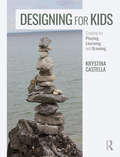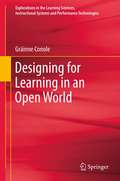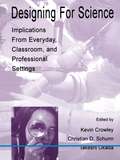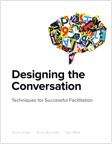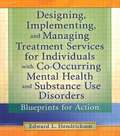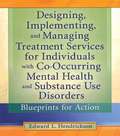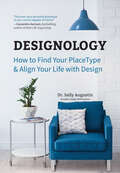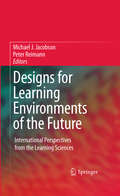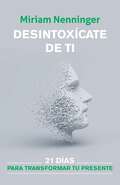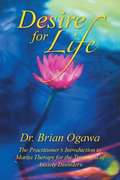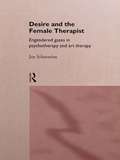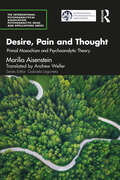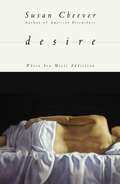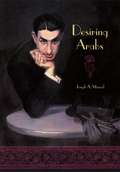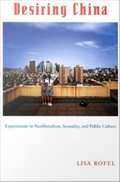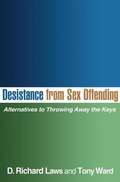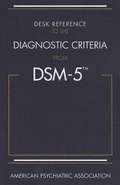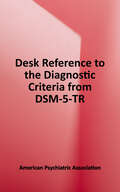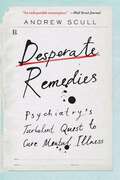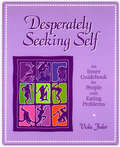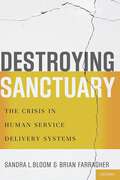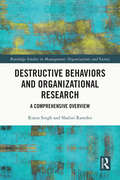- Table View
- List View
Designing for Kids: Creating for Playing, Learning, and Growing
by Krystina CastellaDesigners, especially design students, rarely have access to children or their worlds when creating products, images, experiences and environments for them. Therefore, fine distinctions between age transitions and the day-to-day experiences of children are often overlooked. Designing for Kids brings together all a designer needs to know about developmental stages, play patterns, age transitions, playtesting, safety standards, materials and the daily lives of kids, providing a primer on the differences in designing for kids versus designing for adults. Research and interviews with designers, social scientists and industry experts are included, highlighting theories and terms used in the fields of design, developmental psychology, sociology, cultural anthropology and education. This textbook includes more than 150 color images, helpful discussion questions and clearly formatted chapters, making it relevant to a wide range of readers. It is a useful tool for students in industrial design, interaction design, environmental design and graphic design with children as the main audience for their creations.
Designing for Learning in an Open World
by Gráinne ConoleThe Internet and associated technologies have been around for almost twenty years. Networked access and computer ownership are now the norm. There is a plethora of technologies that can be used to support learning, offering different ways in which learners can communicate with each other and their tutors, and providing them with access to interactive, multimedia content. However, these generic skills don't necessarily translate seamlessly to an academic learning context. Appropriation of these technologies for academic purposes requires specific skills, which means that the way in which we design and support learning opportunities needs to provide appropriate support to harness the potential of technologies. More than ever before learners need supportive 'learning pathways' to enable them to blend formal educational offerings, with free resources and services. This requires a rethinking of the design process, to enable teachers to take account of a blended learning context.
Designing for Science: Implications From Everyday, Classroom, and Professional Settings
by Christian D. Schunn Kevin Crowley Takeshi OkadaThis volume explores the integration of recent research on everyday, classroom, and professional scientific thinking. It brings together an international group of researchers to present core findings from each context; discuss connections between contexts, and explore structures; technologies, and environments to facilitate the development and practice of scientific thinking. The chapters focus on: * situations from young children visiting museums, * middle-school students collaborating in classrooms, * undergraduates learning about research methods, and * professional scientists engaged in cutting-edge research. A diverse set of approaches are represented, including sociocultural description of situated cognition, cognitive enthnography, educational design experiments, laboratory studies, and artificial intelligence. This unique mix of work from the three contexts deepens our understanding of each subfield while at the same time broadening our understanding of how each subfield articulates with broader issues of scientific thinking. To provide a common focus for exploring connections between everyday, instructional, and professional scientific thinking, the book uses a "practical implications" subtheme. In particular, each chapter has direct implications for the design of learning environments to facilitate scientific thinking.
Designing the Complex City: A Systemic Approach to Spatial Design
by Elena PorquedduHow can designers address the emergent self-organizing nature of complex urban environments? Designing the Complex City highlights how both an excess and a lack of design control might contrast the lively complexity of cities, their adaptive and evolutionary capacity. By using key concepts from systems thinking, complexity sciences, life sciences, cognitive sciences, and social sciences, the book frames a systemic spatial design approach aimed at enhancing the potential of different spatial design disciplines to navigate place-specific emergent transformations without overdetermining their formal outcome. A range of heterogeneous case studies, developing at different scales, show how embracing a design approach that is embodied, open-ended, contextually responsive, incremental and adaptive does not question the relevance of designers’ specific skills in shaping the physical structure of cities; it may rather increase their potential to effectively intervene in complex adaptive cycles of urban decay and self-regeneration.Designing the Complex City provides insights for students, researchers, and academics in architecture, interior design, urban and landscape design, planning theory, and urban studies. It is essential reading for all designers who seek to proactively and meaningfully intervene in spontaneous socio-spatial dynamics.
Designing the Conversation: Techniques for Successful Facilitation
by Dan Willis Russ Unger Brad NunnallyFacilitation skills are the foundation of every successful design practice, yet training on this core competency has been largely unavailable--until now. Designing the Conversation: Techniques for Successful Facilitation is a complete guide to developing the facilitation skills you need to communicate effectively and design fully engaging experiences. Learn to take control as Russ Unger, Brad Nunnally, and Dan Willis show you how to use your skills as a facilitator to deftly extract information from different types of people in various scenarios and address any problems and needs that arise along the way. With this book, you will learn how to: Bring together different cross-functional project teams, stakeholders, and clients while balancing their needs, goals, and requirements with those of users Prepare for activities through agenda setting, planning for different types of personalities, and identifying the method of practicing that works best for you Perform group facilitation in workshops, brainstorming sessions, and focus groups Manage individual facilitation activities through interviews, usability testing, sales calls, and mentoring Conduct one-to-many facilitation activities such as presentations, virtual seminars, and lectures Understand how to manage Q & A from audiences of all sizes
Designing, Implementing, and Managing Treatment Services for Individuals with Co-Occurring Mental Health and Substance Use Disorders
by Edward L. HendricksonThe book is a single resource for substance abuse and mental health professionals that provides a broad overview of current bottlenecks, such as resource utiization, staff expertise, funding, etc. and suggests a variety of options concerning how each can be addressed.
Designing, Implementing, and Managing Treatment Services for Individuals with Co-Occurring Mental Health and Substance Use Disorders: Blueprints for Action
by Edward L. HendricksonYour blueprint to develop and manage effective co-occurring treatment programs!Sequential or parallel treatments for co-occurring disorders are much less effective than a quality co-occurring treatment program. Most mental health and substance abuse professionals know how to provide an effective program for individuals with a substance use or mental health disorder, but few are aware of the issues involved in providing services for those with dual diagnosis. Designing, Implementing, and Managing Treatment Services for Individuals with Co-Occurring Mental Health and Substance Use Disorders: Blueprints for Action gives you with the tools you need to develop an effective program specific to co-occurring treatment as well as to implement and manage the program's services. Author Edward Hendrickson shares his knowledge from over two decades of developing and implementing co-occurring treatment services. Designing, Implementing, and Managing Treatment Services for Individuals with Co-Occurring Mental Health and Substance Use Disorders: Blueprints for Action is thorough, insightful, and informative, covering all facets of plan and execution, helping you form strategies to address a co-occurring treatment program&’s unique issues. The book examines the historical basis of the current dual treatment system to provide the philosophical tenets the program must follow and the essential qualities for an effective treatment program. It explores the issues in creating a new program or expanding an existing one, as well as the mechanics of day-to-day management. Helpful appendices, tables, and case examples illustrate the discussion.Designing, Implementing, and Managing Treatment Services for Individuals with Co-Occurring Mental Health and Substance Use Disorders: Blueprints for Action discusses: developing the necessary infrastructure for integrated treatment programs the eight essential qualities for an effective treatment program choosing a target population identifying specific services to implement implementation of services in an existing treatment setting implementation of services in a non-mental health or substance abuse setting hiring and training staff clinical supervision and human resource development program management issues multilevel and multi-organization systems steps to ensure program survivalDesigning, Implementing, and Managing Treatment Services for Individuals with Co-Occurring Mental Health and Substance Use Disorders: Blueprints for Action is more than an instructional text for students; it is an essential resource for any substance abuse and mental health professional considering implementing a co-occurring treatment program.
Designology: How to Find Your PlaceType & Align Your Life with Design
by Dr. Sally AugustinA simple guide to creating spaces at home and work that align with your personality type and support your goals—with the help of science. Discover a new paradigm: Are you an adventurer or a visionary? A maverick or a maven? Designology makes design personal through environmental and design psychologist Sally Augustin&’s 8 personality &“Placetypes&” that characterize the different ways we can relate to the space around us.Personalize everything: What color should you paint your child&’s bedroom? How do shapes and patterns influence how you think in a space? How do room dimensions influence you psychologically? Designology answers all these questions and more with practical how-to advice and real-world examples sure to help make your house a happier place to be.Move forward with your design projects: Bust through the design paralysis that affects so many by applying verified science-based insights. Designology will help you regain control of your design-related efforts with suggestions customized to your personality and space-related needs.Find out what really matters: Designology teaches you how smells, textures, and other factors in your home influence your happiness. It shows you how your personality and ideal design styles are really related. Readers will learn about:· How to sound-scape a place whether they need to concentrate or think creatively· How to use scents in their home to help their family feel healthier· What to read into their spouse&’s desktop landscape· How to use paint to make their living room feel more comfortable· And much more!Take on your intimidating design tasks with confidence using this practical, personalizable how-to guide.
Designs for Learning Environments of the Future
by Peter Reimann Michael J. JacobsonFew things are as certain as societal changes--and the pressing need for educators to prepare students with the knowledge and ways of thinking necessary for the challenges in a changing world. In the forward-thinking pages of Designs for Learning Environments of the Future, international teams of researchers present emerging developments and findings in learning sciences and technologies at the infrastructure, curricular, and classroom levels. Focusing on ideas about designing innovative environments for learning in areas such as biology, engineering, genetics, mathematics, and computer science, the book surveys a range of learning technologies being explored around the world--a spectrum as diverse as digital media, computer modeling, and 3D virtual worlds--and addresses challenges arising from their design and use. The editors' holistic perspective frames these innovations as not only discrete technologies but as flexible learning environments that foster student engagement, participation, and collaboration. Contributors describe possibilities for teaching and learning in these and other cutting-edge areas: Working with hypermodels and model-based reasoning Using visual representations in teaching abstract concepts Designing strategies for learning in virtual worlds Supporting net-based collaborative teams Integrating innovative learning technologies into schools Developing personal learning communities Designs for Learning Environments of the Future will enhance the work of a wide range of professionals, including researchers and graduate students in the learning and cognitive sciences, and educators in the physical and social sciences.
Desintoxícate de ti, y vuelve a elegirte / Your Inner-self Deto x: 21 Days to a new you
by Miriam NenningerEste libro consta de diferentes técnicas que la persona puede realizar para que ella pueda sanar sus heridas tanto las de la infancia como las que pudo haber sufrido luego de una situación traumática, al mismo tiempo que le permitirá reprogramar su cerebro para que, al considerar nuevas creencias y pensamientos positivos sobre su vida, pueda encarar una manera diferente de ver la vida y de transitarla. Este Detox está separado en 21 días. Al mismo tiempo, este consta de un desarrollo central, el cual abarca tanto el problema que el individuo acarrea como las posibles soluciones que puede tener sus circunstancias. Cada capítulo está compuesto por 4 secciones: 1. Declaración: Esta sección tiene como objetivo hablar sobre tu cerebro; 2. Ejercicios: El objetivo de esta sección es que generes consciencia y te ayude a sanar tu alma. 3. Programo mi mente: Esta sección tiene como objetivo reprogramar el cerebro. Mediante la repetición, crearemos nuevas conexiones neuronales donde se instalarán nuevos programas que ayudarán a la persona a transformar de manera saludable sus vínculos, además de ayudarla a cumplir sus objetivos. 4. Meditación: Esta sección es poderosa porque invita a generar congruencia, a que se pongan de acuerdo el espíritu con el alma y con el cuerpo. El libro está basado en un sistema de Programación Neurolingüística, que ayudará al individuo a entender cómo reprogramar su cerebro. Serán procesos emocionales que realizará día a día mientras va logrando la sanidad emocional de los diferentes traumas o situaciones particulares que ha vivido. El Detox de 21 días no sustituye el consejo profesional, sino que es un programa de crecimiento personal y ayudará a la persona a limpiar su interior, a través de sanar, reprogramar y de reintegrar conceptos y hábitos nuevos a su diario vivir, para poder colocarse así en un lugar de paz y de estima que le permita poder volver a elegirse.
Desire For Life: The Practitioner's Introduction To Morita Therapy
by Brian OgawaDesire for Life: The Practitioner's Introduction to Morita Therapy for the Treatment of Anxiety Disorders summarizes key therapeutic goals and methods for applying Morita Therapy to counseling persons experiencing severe anxiety-related disorders, including general anxiety, panic attacks, obsessive-compulsive behaviors, phobias, posttraumatic stress, and hypochondria. This book is a concise and authoritative guide for those who want to incorporate Morita Therapy into their professional practice or teaching of Eastern counseling approaches. The hallmarks of Morita Therapy are holistic well-being, contextual healing, and integrative intervention. This book presents these elements to benefit practitioners and instructors in psychology, counseling, social work, education, human services, medicine, and allied health.
Desire and Human Flourishing: Perspectives from Positive Psychology, Moral Education and Virtue Ethics (Positive Education)
by Magdalena BoschThis book discusses the concept of desire as a positive factor in human growth and flourishing. All human decision-making is preceded by some kind of desire, and we act upon desires by either rejecting or following them. It argues that our views on and expressions of desire in various facets of life and through time have differed according to how human beings are taught to desire. Therefore, the concept has tremendous potential to affect human beings positively and to enable personal growth. Though excellent research has been done on the concepts of flourishing, character education and positive psychology, no other work has linked the concept of desire to all of these topics. Featuring key references, explanations of central concepts, and significant practical applications of desire to various fields of human thought and action, the book will be of interest to students and researchers in the fields of positive psychology, positive education, moral philosophy, and virtue ethics.
Desire and the Female Therapist: Engendered Gazes in Psychotherapy and Art Therapy
by Joy SchaverienDesire and the Female Therapist is one of the first full-length explorations of erotic transference and countertransference from the point of view of the female therapist. Particular attention is given to the female therapist/male client relationship and to the effects of desire made visible in art objects in analytical forms of psychotherapy. Drawing on aesthetic and psychoanalytic theory, specifically Lacan and Jung, the book offers a significant new approach to desire in therapy. Richly illustrated, with pictures as well as clinical vignettes, this book follows on from Joy Schaverien's innovative previous work The Revealing Image. Written primarily for psychotherapists, art therapists and analysts, Desire and the Female Therapist will be essential reading for all therapists affected by erotic transference and countertransference in the course of clinical practice and all whose clients bring art works to therapy.
Desire, Pain and Thought: Primal Masochism and Psychoanalytic Theory (The International Psychoanalytical Association Psychoanalytic Ideas and Applications Series)
by Marilia AisensteinDesire, Pain and Thought presents a new perspective on primal erotogenic masochism, which Marilia Aisenstein regards as the core of psychoanalytic theory. Aisenstein distinguishes between pathological masochism – the active search for pain – and primal erotogenic masochism, which she believes develops in early childhood. Desire, Pain and Thought explains that the formation of this response in a child is essential to the survival of the individual and the development of resilience. Aisenstein skilfully and convincingly uses her deep understanding of metapsychology and her mastery of Freud’s seminal papers to demonstrate that thought is one of the manifestations of desire which implies a painful renunciation of the object of desire. By moving away from its pathological, negative connotation to a more positive one, the book presents an understanding of masochism as “the guardian of life”. Desire, Pain and Thought will be essential reading for psychoanalysts in practice and in training.
Desire: Where Sex Meets Addiction
by Susan CheeverWe've all felt the giddy flutter of excitement when our new lover walks into the room. Waited by the phone, changed our plans...But are we in love, or is there something darker at work? In Desire: Where Sex Meets Addiction, Susan Cheever explores the shifting boundaries between the feelings of passion and addiction, desire and need, and she raises provocative and important questions about who we love and why. Elegantly written and thoughtfully composed, Cheever's book combines unsparing and intimate memoir, interviews and stories, hard science and psychology to explore the difference between falling in love and falling prey to an addiction. Part one defines what addiction is and how it works -- the obsession, the betrayals, the broken promises to oneself and others. Part two explores the possible causes of addiction -- is it nature or nurture, a permanent condition or a temporary derangement? Part three considers what we can do about it, including a provocative suggestion about how we describe and treat addiction, and a look at the importance of community and storytelling. In the end, there are no easy answers. "A straight look about some crooked feelings," Desire shows us the difference between the addiction that cripples our emotions, and healthy, empowering love that enhances our lives.
Desiring Arabs
by Joseph A. Massad<p>Sexual desire has long played a key role in Western judgments about the value of Arab civilization. In the past, Westerners viewed the Arab world as licentious, and Western intolerance of sex led them to brand Arabs as decadent; but as Western society became more sexually open, the supposedly prudish Arabs soon became viewed as backward. Rather than focusing exclusively on how these views developed in the West, in Desiring Arabs Joseph A. Massad reveals the history of how Arabs represented their own sexual desires. To this aim, he assembles a massive and diverse compendium of Arabic writing from the nineteenth century to the present in order to chart the changes in Arab sexual attitudes and their links to Arab notions of cultural heritage and civilization. <p>A work of impressive scope and erudition, Massad’s chronicle of both the history and modern permutations of the debate over representations of sexual desires and practices in the Arab world is a crucial addition to our understanding of a frequently oversimplified and vilified culture.</p>
Desiring China: Experiments in Neoliberalism, Sexuality, and Public Culture
by Lisa RofelThrough window displays, newspapers, soap operas, gay bars, and other public culture venues, Chinese citizens are negotiating what it means to be cosmopolitan citizens of the world, with appropriate needs, aspirations, and longings. Lisa Rofel argues that the creation of such "desiring subjects" is at the core of China's contingent, piece-by-piece reconfiguration of its relationship to a post-socialist world. In a study at once ethnographic, historical, and theoretical, she contends that neoliberal subjectivities are created through the production of various desires--material, sexual, and affective--and that it is largely through their engagements with public culture that people in China are imagining and practicing appropriate desires for the post-Mao era. Drawing on her research over the past two decades among urban residents and rural migrants in Hangzhou and Beijing, Rofel analyzes the meanings that individuals attach to various public cultural phenomena and what their interpretations say about their understandings of post-socialist China and their roles within it. She locates the first broad-based public debate about post-Mao social changes in the passionate dialogues about the popular 1991 television soap opera Yearnings. She describes how the emergence of gay identities and practices in China reveals connections to a transnational network of lesbians and gay men at the same time that it brings urban/rural and class divisions to the fore. The 1999-2001 negotiations over China's entry into the World Trade Organization; a controversial women's museum; the ways that young single women portray their longings in relation to the privations they imagine their mothers experienced; adjudications of the limits of self-interest in court cases related to homoerotic desire, intellectual property, and consumer fraud--Rofel reveals all of these as sites where desiring subjects come into being.
Desistance from Sex Offending
by D. Richard Laws Tony WardThis book offers a fresh perspective on treating a population that is often demonized by policymakers, the public, and even clinicians. The authors argue that most sex offenders are "people like us," with the potential to lead meaningful, law-abiding lives if given a chance and appropriate support. They describe an empirically and theoretically grounded rehabilitation approach, the Good Lives Model, which can be integrated with the assessment and intervention approaches that clinicians already use. Drawing on the latest knowledge about factors promoting desistance from crime, the book discusses how encouraging naturally occurring desistance processes, and directly addressing barriers to community reintegration, can make treatment more effective and long lasting.
Desk Reference to the Diagnostic Criteria From DSM-5
by American Psychiatric AssociationThe Desk Reference to the Diagnostic Criteria From DSM-5 is meant to be used in conjunction with the full DSM-5. Its proper use requires familiarity with the text descriptions for each disorder that accompany the criteria sets. This handy reference provides all ICD-9-CM and ICD-10-CM codes, coding notes, and recording procedures included in DSM-5. Clinicians will find additional reference information in DSM-5, including Section III: Emerging Measures and Models (containing assessment measures, cultural formulation and interviews, an alternative DSM-5 model for personality disorders, and conditions for further study) and the DSM-5 Appendix (containing highlights of changes from DSM-IV, glossaries of technical and cultural terms, and alphabetical and numerical listings of DSM-5 diagnoses and codes).
Desk Reference to the Diagnostic Criteria from DSM-5-TR
by American Psychiatric AssociationThe Desk Reference to the Diagnostic Criteria From DSM-5-TR is a concise, affordable companion to the ultimate psychiatric reference, DSM-5-TR. It includes the fully revised diagnostic classification, as well as all the diagnostic criteria from DSM-5-TR in an easy-to-use format. This handy reference provides quick access to the information essential to making a diagnosis. Designed to supplement DSM-5-TR, this convenient guide will assist all mental health professionals as they integrate the DSM-5-TR diagnostic criteria into their diagnoses. The Diagnostic and Statistical Manual of Mental Disorders stands alone as the most authoritative reference available for clinical practice in the mental health field. The Desk Reference to the Diagnostic Criteria From DSM-5-TR distills the most crucial, updated diagnostic information from this volume to provide clinicians with an invaluable resource for effectively diagnosing mental disorders, ranging from the most prevalent to the least common.
Desperate Remedies: Psychiatry’s Turbulent Quest to Cure Mental Illness
by Andrew ScullA sweeping history of American psychiatry—from prisons to hospitals to the lab to the analyst’s couch—by the award-winning author of Madness in Civilization. For more than two hundred years, disturbances of the mind—the sorts of things that were once called “madness”—have been studied and treated by the medical profession. Mental illness, some insist, is a disease like any other, whose origins can be identified and from which one can be cured. But is this true? In this masterful account of America’s quest to understand and treat everything from anxiety to psychosis, one of the most provocative thinkers writing about psychiatry today sheds light on its tumultuous past. Desperate Remedies brings together a galaxy of mind doctors working in and out of institutional settings: psychologists and psychoanalysts, neuroscientists, and cognitive behavioral therapists, social reformers and advocates of mental hygiene, as well as patients and their families desperate for relief. Andrew Scull begins with the birth of the asylum in the reformist zeal of the 1830s and carries us through to the latest drug trials and genetic studies. He carefully reconstructs the rise and fall of state-run mental hospitals to explain why so many of the mentally ill are now on the street and why so many of those whose bodies were experimented on were women. In his compelling closing chapters, he reveals how drug companies expanded their reach to treat a growing catalog of ills, leading to an epidemic of over-prescribing while deliberately concealing debilitating side effects. Carefully researched and compulsively readable, Desperate Remedies is a definitive account of America’s long battle with mental illness that challenges us to rethink our deepest assumptions about who we are and how we think and feel.
Desperately Seeking Self
by Viola FodorThis little book is a powerful reminder that your true nature is the most precious resource that you have to help yourself. Presented in the unique form of a dialogue between a therapist and a client, it encourages self-reflection and the daily practice of inner silence as powerful ways to nurture this true self and your full healing capacity. Tenets of psychology, philosophy, and spirituality are subtly woven into easily-understood messages of hope and change.
Después de la infidelidad: Sanando el dolor y restableciendo la con
by Dr Janis A. SpringDespués de la infidelidad muestra como las parejas pueden sanar y crecer a partir de la desastrosa crisis de infidelidad. En base a sus treinta y cinco años de experiencia como psicólogo clínico, el doctor Spring ofrece una serie original de estrategias comprobadas que dan respuesta a preguntas como «¿Por qué pasó esto?» «Una vez que se pierde el amor y la confianza ¿podemos recuperarlos?» « ¿Puedo—debo— comprometerme nuevamente si me siento confundido?» «¿Cómo tenemos intimidad sexual de nuevo?» «¿Es posible perdonar?» «¿Qué constituye una infidelidad en el ciberespacio?»
Destroying Sanctuary: The Crisis In Human Service Delivery Systems
by Sandra L. BloomFor the last thirty years, the nation's mental health and social service systems have been under relentless assault, with dramatically rising costs and the fragmentation of service delivery rendering them incapable of ensuring the safety, security, and recovery of their clients. The resulting organizational trauma both mirrors and magnifies the trauma-related problems their clients seek relief from. Just as the lives of people exposed to chronic trauma and abuse become organized around the traumatic experience, so too have our social service systems become organized around the recurrent stress of trying to do more under greater pressure: they become crisis-oriented, authoritarian, disempowered, and demoralized, often living in the present moment, haunted by the past, and unable to plan for the future. <p><p> Complex interactions among traumatized clients, stressed staff, pressured organizations, and a social and economic climate that is often hostile to recovery efforts recreate the very experiences that have proven so toxic to clients in the first place. Healing is possible for these clients if they enter helping, protective environments, yet toxic stress has destroyed the sanctuary that our systems are designed to provide. <p><p> This thoughtful, impassioned critique of business as usual begins to outline a vision for transforming our mental health and social service systems. Linking trauma theory to organizational function, Destroying Sanctuary provides a framework for creating truly trauma-informed services. The organizational change method that has become known as the Sanctuary Model lays the groundwork for establishing safe havens for individual and organizational recovery. The goals are practical: improve clinical outcomes, increase staff satisfaction and health, increase leadership competence, and develop a technology for creating and sustaining healthier systems. Only in this way can our mental health and social service systems become empowered to make a more effective contribution to the overall health of the nation. <p><p> Destroying Sanctuary is a stirring call for reform and recovery, required reading for anyone concerned with removing the formidable barriers to mental health and social services, from clinicians and administrators to consumer advocates.
Destructive Behaviors and Organizational Research: A Comprehensive Overview (Routledge Studies in Management, Organizations and Society)
by Riann Singh Shalini RamdeoDestructive organizational behaviors including destructive leadership, abusive supervision, workplace bullying, sexual harassment in the workplace, workplace deviance, workplace incivility, workplace ostracism, social loafing, and workplace discrimination and injustice are explored in this book. These destructive organizational behaviors and negative perspectives have emerged as the most pervasive forms of mistreatment in today’s workplace with the most costly and disastrous consequences across all levels: employees, teams, and organizations. This volume synthesizes and critically evaluates existing research and identifies future directions through research gaps on the most destructive organizational behaviors in today’s workplace. Strategies for managing such behaviors and potential contextual variations in destructive behaviors are also assessed. Alternative negative perspectives on traditionally positive organizational behaviors are examined. There is a paucity of research on the darker side of organizational behaviors, although such destructive behaviors are indeed pervasive in today’s workplace. Providing researchers with a comprehensive overview and analysis of research advances on selected destructive organizational behaviors, this book also considers the need of researchers to delineate future research opportunities to advance the field of study. It seeks to spur critical thinking, spark alternative research perspectives, and provide the foundation from which focused future research can develop. It also considers managerial and international perspectives through an assessment of strategies for managing destructive behaviors and contextual reflections on destructive organizational behaviors, making it a valuable resource for researchers, academics, and students in the fields of organizational behavior, psychology, management, leadership and strategy.
